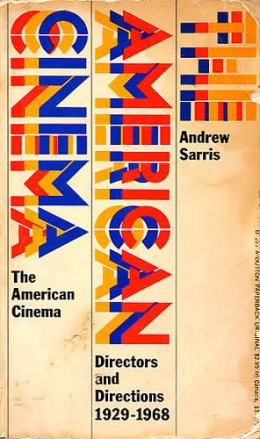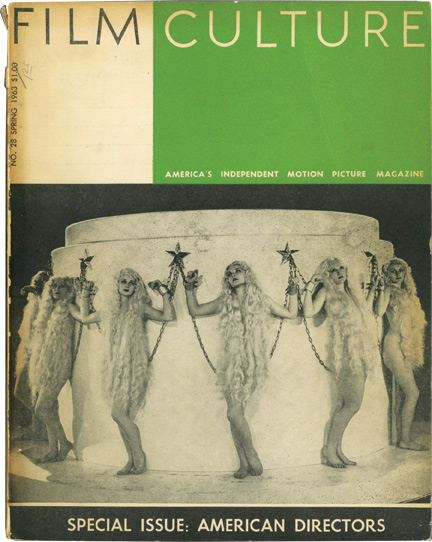From Film Society Review (Vol. 4, No. 5, January 1969) — the first magazine, apart from school and college publications, where I ever published film criticism, for a total of three issues. This was my third and final piece for them. — J.R.
Jon Rosenbaum
THE AMERICAN CINEMA: DIRECTORS AND DIRECTIONS 1929-1968, by Andrew Sarris, New York: E.P. Dutton & Co., Inc., 1968. 383 pp. $7.95, $2.95 (paperback).
Ever since it came out, I have been stubbornly holding on to the Spring 1963 issue of FILM CULTURE, which features a 68-page extravaganza by Andrew Sarris entitled THE AMERICAN CINEMA. ‘Extravaganza’, is not, I think, an overblown word to use here: the program includes detailed descriptions, evaluations and filmographies of over 100 film directors, with a supplementary list of more than 150 “Other Directors” and a “Directorial Chronology” of American films from l9l5 to 1962. At the time, the very fact that one man had seen enough movies to reach this kind of astronomical overview was staggering enough. Just as challenging — and in its own way, unnerving — were the nine categories under which the first hundred-odd directors were pigeon-holed: “Pantheon Directors,” “Second Line,” “Third Line,” “Esoterica,” “Beyond the Fringe,” “Fallen ldols,” ”Likable But Elusive,” “Minor Disappointments” and “Oddities and One Shots” — an almost metaphysical ordering of the American movie universe that looked so painstaking it was painful — and rather threatening, I believe, even to some of the most veteran of moviegoers. What was Sarris doing to us, and to himself? Who was Howard Hawks (in the Pantheon along with Griffith, Chaplin, Renoir and Welles), Samuel Fuller, Douglas Sirk (Second Line), Donald Siegel and Edgar G. Ulmer (Esoterica)? The implication was either that by ignoring such presences we were wasting our time at the movies, or that by pursuing them, Sarris was wasting his.
In the six years that have elapsed since then, Sarris’ judgments have had a gradual, subterranean, but decisive effect on American film tastes, principally through his weekly column in THE VILLAGE VOICE. And the recent appearance of an extensively revised and expanded compendium –- THE AMERICAN ClNEMA: DIRECTORS AND DlRECTIONS, 1929-1968 -– takes place in a cultural climate that has changed considerably. (At this writing, for example, U.C.L.A.’s film program includes a seminar on the films of Howard Hawks.) Even if Garbo and Bogart retrospectives are still much more popular at art theaters than directors series, many of Sarris’ original observations and insights have since become taken for granted, particularly by filmgoers of a younger generation. ln 1963, despite many commonsensical statements, THE AMERICAN CINEMA was a shocker. Today, despite its shortcomings, it is already on its way to becoming a classic of sorts.
To place it ‘historically,’ version #1 of THE AMERICAN CINEMA appeared somewhere in the middle of the Great Auteur War, a controversy that enlivened as well as soured a great deal of American film criticism in the early sixties. (For documentation, cf. Pauline Kael’s “Circle and Squares” in I LOST IT AT THE MOVIES and Sarris’ “Notes on the Auteur Theory in 1962” in the Winter, 1962-63 FILM CULTURE, as well as his introduction to the present volume.) But Sarris’ strengths have always been as a reviewer and chronicler rather than as a theorist or polemicist, and the particular values of THE AMERICAN CINEMA must be seen in this context. As criticism, Sarris’ THE FILMS OF JOSEF VON STERNBERG (1966) is more carefully written and judiciously balanced; but as a sort of pioneering catalogue-guide to the American cinema, his new book is indispensable. Precisely how and why it is indispensable can perhaps best be seen if I first outline some of its limitations:
(1) The problem of scope. In the first section alone, devoted to 14 “Pantheon Directors,” Sarris has assigned himself the task of writing about men whose combined filmographies, shorts included, add up to nearly 1,000 films. Obviously this requires a kind of critical shorthand and some very broad descriptions. At least theoretically, Sarris’ style is amenable to this; largely a matter of condensing and connecting a variety of impressions with puns, metaphors and analogies (like Manny Farber’s style, which carries this tendency further), it can be immensely rewarding when it works. When it doesn’t, it becomes phrase-making: belletristic mannerism in which the pun or metaphor precedes or blots out (at any rate, replaces) the idea it is meant to convey.The worst perpetrators of this syndrome that I can think of are John Simon — mainly in his assaults against Godard — and the anonymous scribes of TIME. Ironically, Sarris manages to communicate interesting ideas more frequently then either because his style tends to be less polished: even when the images crack, the concepts usually come across.
(2) The problem of categories, These have been altered somewhat since the first version; fortunately, some awkward designations (such as “Second Line” and “Third Line”) have been scrapped or replaced.Still, the very existence of categories inevitably produces certain irritations, and encourages varying amounts of patness and oversimplification. The justifications offered by Sarris in his Introduction have some point to them (“One reason is to establish a system of priorities for the film student. Another is the absence of the most elementary academic tradition in cinema”), but they also raise several questions of their own, and they bypass the probable dangers of rationalization (what Dwight Macdonald has called the Procrustean Bed) inherent in such classifying. In addition, when mated with the belletristic style, the categories sometimes bring up
(3) The problem of consistency. The section entitled “Less Than Meets the Eye,” for example, is prefaced in the following way: “These are the directors with reputations in excess of inspirations. In retrospect, it always seems that the personal signatures to their films were written with invisible ink.” Even if one can swallow that “always,” as soon as one turns the page to read Sarris’ comments on John Huston, one finds him him describing the director not as some anonymous craftsman but as an auteur he doesn’t like. (His description, moreover, is quite persuasive.) Turning another page, one reads that the best films of Joseph Mankiewicz “bear the signature of a genuine auteur.” But how can you read a signature that isn’t visible?
(4) The problem of accurate information. In an era when badly researched film books are coming out virtually every week, it may be niggling to point out that Robert Flaherty was not a co-director of TABU (although he collaborated on the original story), or that LA GRANDE ILLUSION and LA MARSEILLAISE are omitted from Jean Renoir’s filmography. At any rate, the second mistake is undoubtedly a printer’s error, as I suspect most of the others are. In general, when one considers the wealth of information in this book — particularly the filmographies — the level of accuracy seems far above the norm.
(5) The problem of usefulness, or: why talk about so many films that can’t be seen? Two possible answers to this are (a) that Sarris is chronicling as well as recommending, and (b) (delivered with a gulp and a sigh): television. Many of the films, of course, can no longer be seen at all. It is also quite clear that there are several Sarris hasn’t seen — which raises questions concerning his practice of italicizing “works of special interest” in the filmographies, since one is occasionally in doubt whether some work is un-italicized because Sarris hasn’t seen it, because (in the case of some final entries) it hasn’t been made yet, or merely because it isn’t special enough.
As for television, the various corruptions, distortions and losses suffered by movies on the home screen are too extensive (and all too familiar) to be enumerated here. Practically speaking, a moviegoer who wants to see several films by a single director must either wait for a rare retrospective — if he is lucky enough to live in an area that has them — or check the weekly pages of TV GUIDE. Until the hypothetical day arrives when we can purchase films as easily as books, when the collected works of Chaplin will be no less available to homes than a complete set of Dickens, television will have to function as a poor substitute for private archives.
For anyone willing to accept this ‘compromise,’ THE AMERICAN CINEMA becomes immediately usable. I have not yet mentioned the book’s pièce de resistance, a “Directorial lndex to the American Cinema,” compiled by Michael Schwartz and James R. Pickett, which comprises the last 83 pages. Although as Sarris points out, their list “falls short of our original goal (a listing of every American film ever made)”– considerably short, as anyone using the index will quickly see — there are still approximately 6,000 titles with the appropriate dates and directors.
(6) The problem of criteria. Apart from the last 83 pages, how complete is Sarris’ survey intended to be? If characters like Bud Yorkin and William Dieterle were included, why were characters like Norman Taurog and Edward Dmytryk left out? lf some British directors are acceptable, why are others excluded? This is a rather small quibble to make — what, after all, is the dividing line between worthlessness and mediocrity? — but it involves a much wider issue: What is Sarris looking for when he sees a film?
A phrase which keeps cropping up in THE AMERICAN CINEMA, and which makes me uncomfortable, is “directorial personality.” My major gripe is with neither the term itself nor what it means (these are minor gripes, since it is usually clear that Sarris is talking about style), but rather with an implication that Sarris sometimes seems to make inadvertently — that the presence of ‘personality’ guarantees some kind of quality. Needless to say, such a notion immediately sounds silly if transposed to any of the other arts, and if Sarris doesn’t mean this, I wish that he’d been clearer about it. The creation of this ambiguity seems to come from shifting criteria, which theoretically can enliven a reviewing if the inconsistencies are separated by weeks, but which can make for real confusion when found on successive pages of a book.
That is why THE AMERICAN CINEMA is best approached as a critical reference to dip into — a sturdy volume to place somewhere near one’s television set, just as dictionaries are useful next to typewriters and reading chairs. Like most dictionaries, Sarris’ guidebook is tar from infallible (although unlike most dictionaries, it doesn’t pretend to be); it is hard to read it for very long without disagreeing with some judgment or observation. But ‘rightness’ and ‘wrongness’ as critical values are ultimately too solipsistic to be of much use in criticism (except for during those solipsistic moments each of us have) -– what matters most is illumination. And what finally matters about Sarris, thumbnail descriptions is that the best of them always reveal more about movies than we originally thought was there. At the very least they tell us that something is there, when otherwise we might never have looked.






